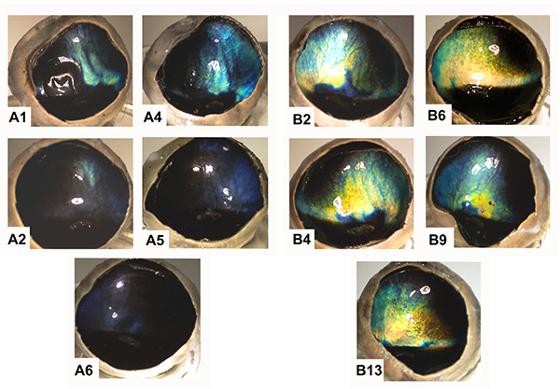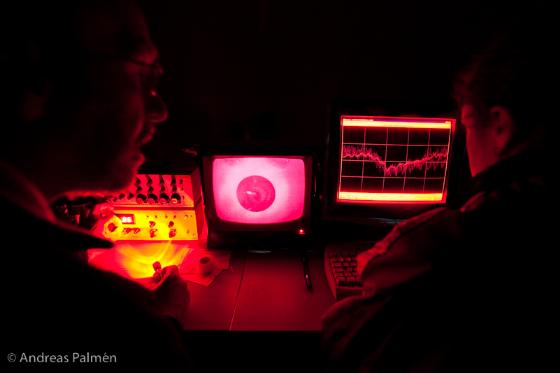Rudolph's eyes turn blue for Christmas
Everyone talks about Rudolph the reindeer’s red nose. But the most remarkable thing about reindeer is that their eyes change colour in the winter from gold to blue.
A reindeer’s eyes are like the eyes of a cat – they reflect light in the darkness. This characteristic explains the flash you see when the light from your car headlights strikes the eyes of an animal at night.
Researchers at UiT The Arctic University of Norway have now discovered that while reindeer eyes flash a gold-green colour in the summer, this reflected light shifts to a deep blue colour in the winter darkness.
You could say that Rudolph's eyes turn blue for Christmas. Nothing like this has been found in any other animal.
 |
| There is a distinct difference in eye colour in reindeer eyes collected in winter and summer. Winter eyes are deep blue. Photo: Department of Arctic and marine biology. |
“Our study shows that the reindeer’s eyes are specially adapted to the lighting conditions that characterize high latitudes. This has never been reported before, because no one has looked at animals that experience extreme light conditions throughout the year,” says Professor Karl-Arne Stokkan.
Would be harmful for humans
Many animals have a light-reflecting surface behind the retina called the tapetum lucidum, a Latin word that translates as “bright carpet.”
The tapetum reflects light inside the eye so it has more time to stimulate light-sensitive receptors in the retina. This is the structure that changes colour in the reindeer eye with the approach of the dark days of Christmas.
Stokkan explains that the eye has a cellular pump that pumps fluid into the eye. The only way for the fluid to escape is through a good drainage system behind the eye. But, he says, when it is dark and the animal’s pupils are greatly expanded, it is as if a curtain has covered this drainage system.
“This increases the pressure in the animal’s eye. The difference between summer and winter pressures are also significant,” he says. “Pressures also increase slightly in the human eye at night. But the pressures we have measured in the reindeer eye in winter are so high that they would be harmful in the human eye.”
Blue eyes improve vision in the shadows
“The fibres in the reindeer’s tapetum are brought closer together because of this pressure, which changes the colour of the reflected light. This means that the eye’s light sensitivity is increased, because blue light is scattered more than yellow light,” said Stokkan.
 |
| Researchers use an instrument called an electroretinogram to measure the sensitivity of the eye to light. The instrument measures the electrical responses in the eye when there is a specific light stimulus. Photo: Andreas Palmén |
When the blue light is reflected, light is spread laterally onto the retina and many light receptors are simultaneously stimulated. The downside is that the image is blurred and visual acuity is actually worse. But the advantage is that the animals are considerably more sensitive to movement in the shadows in winter, which means they can detect predators in the dark more easily.
“Reindeer herders are very familiar with this phenomenon. They say that if you stand still just a short distance from a herd of reindeer in the winter, they won’t see you, but as soon as you move the animals startle and run away,” Stokkan says.
Curiosity-driven
At the same time, reindeer can take advantage of their sharper vision in the bright summer months.
Karl-Arne Stokkan describes his research on reindeer eyes as “curiosity-driven research”, with no immediate practical application.
Nevertheless, it is interesting enough that the British Research Council has supported the research project with a NOK 2 million grant. The project is being undertaken in collaboration with University College London and its affiliate, the Moorfields Eye Hospital, which is one of the world 's leading eye clinics.
The research project is a continuation of a study that showed that reindeer see ultraviolet light. Reindeer were the first large mammal known to have UV vision.
“Our finding that a reindeer’s eye colour can change may also hold true for other animals. But we were the first to discover this, as well as the first to discover that large mammals have ultraviolet vision,” Stokkan notes. “An extensive amount of research has now been conducted in this field, and initial results suggest that only humans and some species of monkeys cannot see UV light. All other animals can see it.”
The researchers’ findings on changing eye colour in reindeer have been published in the British journal Proceedings of the Royal Society.
Stokkan K-A, Folkow L, Dukes J , Nevue M , Hogg C , Siefken S, Dakin SC , Jeffery G. 2013
Shifting mirrors: adaptive changes in retinal reflections to winter darkness in Arctic reindeer.
Proc R Soc B 20132451
Translated by Nancy Bazilchuk